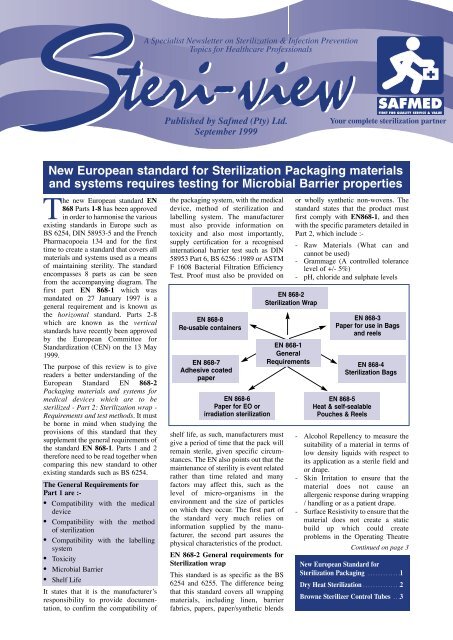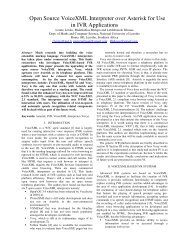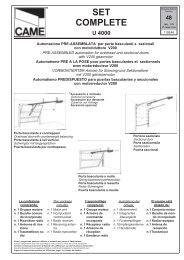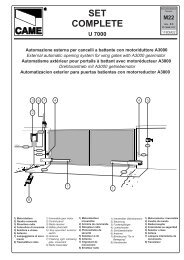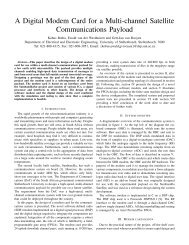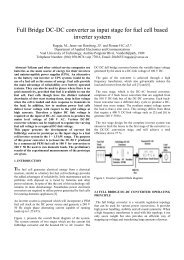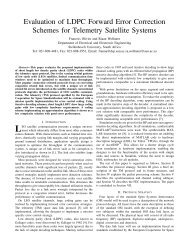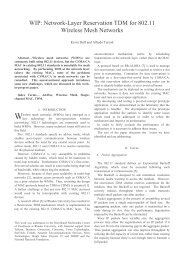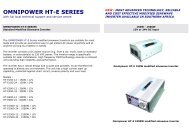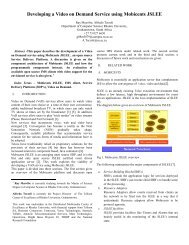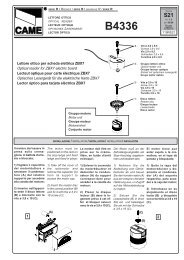New European standard for Sterilization Packaging ... - Intekom
New European standard for Sterilization Packaging ... - Intekom
New European standard for Sterilization Packaging ... - Intekom
- No tags were found...
You also want an ePaper? Increase the reach of your titles
YUMPU automatically turns print PDFs into web optimized ePapers that Google loves.
A Specialist <strong>New</strong>sletter on <strong>Sterilization</strong> & Infection PreventionTopics <strong>for</strong> Healthcare ProfessionalsPublished by Safmed (Pty) Ltd.September 1999Your complete sterilization partner<strong>New</strong> <strong>European</strong> <strong>standard</strong> <strong>for</strong> <strong>Sterilization</strong> <strong>Packaging</strong> materialsand systems requires testing <strong>for</strong> Microbial Barrier propertiesThe new <strong>European</strong> <strong>standard</strong> EN868 Parts 1-8 has been approvedin order to harmonise the variousexisting <strong>standard</strong>s in Europe such asBS 6254, DIN 58953-5 and the FrenchPharmacopoeia 134 and <strong>for</strong> the firsttime to create a <strong>standard</strong> that covers allmaterials and systems used as a meansof maintaining sterility. The <strong>standard</strong>encompasses 8 parts as can be seenfrom the accompanying diagram. Thefirst part EN 868-1 which wasmandated on 27 January 1997 is ageneral requirement and is known asthe horizontal <strong>standard</strong>. Parts 2-8which are known as the vertical<strong>standard</strong>s have recently been approvedby the <strong>European</strong> Committee <strong>for</strong>Standardization (CEN) on the 13 May1999.The purpose of this review is to givereaders a better understanding of the<strong>European</strong> Standard EN 868-2<strong>Packaging</strong> materials and systems <strong>for</strong>medical devices which are to besterilized - Part 2: <strong>Sterilization</strong> wrap -Requirements and test methods. It mustbe borne in mind when studying theprovisions of this <strong>standard</strong> that theysupplement the general requirements ofthe <strong>standard</strong> EN 868-1. Parts 1 and 2there<strong>for</strong>e need to be read together whencomparing this new <strong>standard</strong> to otherexisting <strong>standard</strong>s such as BS 6254.The General Requirements <strong>for</strong>Part 1 are :-• Compatibility with the medicaldevice• Compatibility with the methodof sterilization• Compatibility with the labellingsystem• Toxicity• Microbial Barrier• Shelf LifeIt states that it is the manufacturer’sresponsibility to provide documentation,to confirm the compatibility ofthe packaging system, with the medicaldevice, method of sterilization andlabelling system. The manufacturermust also provide in<strong>for</strong>mation ontoxicity and also most importantly,supply certification <strong>for</strong> a recognisedinternational barrier test such as DIN58953 Part 6, BS 6256 :1989 or ASTMF 1608 Bacterial Filtration EfficiencyTest. Proof must also be provided onEN 868-8Re-usable containersEN 868-7Adhesive coatedpaperEN 868-6Paper <strong>for</strong> EO orirradiation sterilizationshelf life, as such, manufacturers mustgive a period of time that the pack willremain sterile, given specific circumstances.The EN also points out that themaintenance of sterility is event relatedrather than time related and manyfactors may affect this, such as thelevel of micro-organisms in theenvironment and the size of particleson which they occur. The first part ofthe <strong>standard</strong> very much relies onin<strong>for</strong>mation supplied by the manufacturer,the second part assures thephysical characteristics of the product.EN 868-2 General requirements <strong>for</strong><strong>Sterilization</strong> wrapThis <strong>standard</strong> is as specific as the BS6254 and 6255. The difference beingthat this <strong>standard</strong> covers all wrappingmaterials, including linen, barrierfabrics, papers, paper/synthetic blendsEN 868-2<strong>Sterilization</strong> WrapEN 868-1GeneralRequirementsor wholly synthetic non-wovens. The<strong>standard</strong> states that the product mustfirst comply with EN868-1, and thenwith the specific parameters detailed inPart 2, which include :-- Raw Materials (What can andcannot be used)- Grammage (A controlled tolerancelevel of +/- 5%)- pH, chloride and sulphate levelsEN 868-3Paper <strong>for</strong> use in Bagsand reelsEN 868-4<strong>Sterilization</strong> BagsEN 868-5Heat & self-sealablePouches & Reels- Alcohol Repellency to measure thesuitability of a material in terms oflow density liquids with respect toits application as a sterile field andor drape.- Skin Irritation to ensure that thematerial does not cause anallergenic response during wrapping/ handling or as a patient drape.- Surface Resistivity to ensure that thematerial does not create a staticbuild up which could createproblems in the Operating TheatreContinued on page 3<strong>New</strong> <strong>European</strong> Standard <strong>for</strong><strong>Sterilization</strong> <strong>Packaging</strong> . . . . . . . . . . . . .1Dry Heat <strong>Sterilization</strong> . . . . . . . . . . . . . . .2Browne Sterilizer Control Tubes . . .31
Continued from page 1STRENGTH REQUIREMENTS (TABLE 1)Properties Units Plain Creped Non-wovenPaper Paper PaperInternal tearing resistance MD mN 500 min 750 minInternal tearing resistance CD mN 1000 minDry Bursting strength kPa 110 min 130 minWet Bursting strength kPa 35 min 90 minDry tensile strength MD kN/m 1.33 min 1.33 minDry tensile strength CD kN/m 0.67 min 0.67 minWet tensile strength MD kN/m 0.33 min 0.33 minWet tensile strength CD kN/m 0.27 min 0.27 minElongation at break MD % 10 min 5 minElongation at break CD % 2 min 7 minBARRIER REQUIREMENTS (TABLE 2)Properties Units Plain Creped Non-wovenPaper Paper PaperAir Permeance µm/Pa.S 1.7 minAir Permeance L/min/100 cm 2 10 minWater repellency seconds 30 min 20 minSaline repellency (Mason jar) minutes 75 minEquivalent Pore size diameter µm 50 max 50 maxSurface absorbency (Cobb) g/m 2 20 maxDRAPE REQUIREMENTS (TABLE 3)Properties Units Plain Creped Non-wovenPaper Paper PaperDrape MD (EN 868-2) mm 125 max 125 maxDrape CD (EN 868-2) mm 160 max 160 maxDrapeability (ISO 9073-9) % 85 maxEN 868-2 Specific Requirements <strong>for</strong><strong>Sterilization</strong> wrapThe <strong>standard</strong> then details the physicalcharacteristics necessary <strong>for</strong> Plainpaper, Crepe paper, and Non-wovens(which include linen, barrier fabrics,paper/synthetic blends or whollysynthetic materials). These requirementscan be categorised as follows :-Strength (Table 1)- Tear Strength inorder to avoidripping on the sharpcorners of trays- Wet and Dry BurstStrength in order toprevent the packfrom bursting duringthe autoclavecycle- Wet and Drytensile strength toavoid tearing duringwrapping andhandling- Stretch to ensurethe elongation ofthe material andthereby differentiateit from otherpapersBarrier (Table 2)- Air Permeancein order to allowthe sterilant topenetrate the pack,as well as to allow<strong>for</strong> its subsequentdispersal- Water repellency to prevent theingress of water-borne bacteria- Mason Jar to measure the suitabilityof a material, in terms of fluidresistance, with respect to itsapplication as a sterile field ordrape.- Pore size in order to control theingress of air-borne bacteria- Surface absorbency to reduce theopportunity of fluid penetration,which would create an aqueous path<strong>for</strong> bacteria.Drapeability (Table 3)- Drapeability in order to enable theaseptic opening of the inner wrapIt can be seen from Tables 1, 2 and 3that different specific requirements andtest methods apply to the differenttypes of <strong>Sterilization</strong> wrap. It isthere<strong>for</strong>e not possible to directlycompare the per<strong>for</strong>mance of one gradeof wrap to another from manufacturer’sspecifications. The <strong>standard</strong>does however, require that themanufacturer to identify what type ofwrap (Plain Paper, Creped Paper orNon-Woven) he is supplying and that itmeets the requirements of the <strong>standard</strong>in all respects.ConclusionThese criteria have been designed tosafeguard and provide the end userwith a suitable system <strong>for</strong> packagingmaterials that require sterilization.Thereis a perception in theSouth African market that therequirements of EN 868 Parts 1 and 2are less onerous than the longstanding BS 6254 and BS 6255<strong>standard</strong>s. This is not the case and thedictum caveat emptor (let the buyerbeware), very much applies to thepurchasing of <strong>Sterilization</strong> wrap byyour particular hospital.Browne TM Sterilizer Control Tubes offer an effective andimmediate check <strong>for</strong> Dry Heat <strong>Sterilization</strong>Browne Sterilizer Control Tubesallow you to easily andeconomically monitor your dry heatand fluid sterilization processes.The design of the tube is perfectlysuited <strong>for</strong> use not only in dry heat butalso in fluid sterilization where thetube can actually be placed in acontrol sample of the solution beingsterilized. Browne Tubes havealways been, and still are the mosteffective chemical indicators <strong>for</strong>routine monitoring of dry heat andfluid sterilization, particularly asthey offer significant time and costsavings over thermocouple andmicro biological test methods.Easy To UseSelect the Control Tube suited toyour sterilizationparameters (time/ Time to go Green (mins.)temperature) and 100distribute them 90throughout the load. 80For dry heat place 70the tubes throughout 60the load closely besideor inside the5040most inaccessible30articles to be sterilized.(Instructions2010<strong>for</strong> use and colourguides are includedwith each box). TheBrowne Control Tubes will showyou immediately if the time attemperature was achieved.Type 4 TubesTemp °C150°C160°C170°C180°C190°CTime (mins.)854524126150°C 160°C 170°C 180°C 190°C Temp.3
Continued from page 2accordance with the temperaturedifferences within the chamber. Coldair enters at the bottom, is heated andtravels upwards within the chamber.The colder air in the chamber is <strong>for</strong>ceddownward, is heated and circulatesupward. As the heated air rises it givesup part of its heat to the items beingsterilized, is cooled, descends, isheated by the heater plate and thenrises in a continuous pattern.The pattern followed by the air islargely dependent upon the design ofthe unit. This type is the slowest, withthe least amount of uni<strong>for</strong>mtemperature control, and is the mostlikely to develop hot and cold spots. Ithas the fewest moving parts andthere<strong>for</strong>e is the least expensive both inacquisition and maintenance costs.The Mechanical Convection hot airsterilizer offers the maximum infunctional efficiency at the minimumcost. It differs from the gravityconvection system in that a mechanicalblower (fan) is used to convey heatdirectly to the load under controlledtemperature conditions.Typically the heated air is directed to ablower chamber where it is mixed withre-circulating air. This temperaturecontrolled air is then passed into achamber containing a per<strong>for</strong>ateddiffuser, which distributes the airuni<strong>for</strong>mly over the items to besterilized to the opposite wall where itis similarly exhausted. This ensuresuni<strong>for</strong>m temperature distribution andequal transfer of heat to all areaswithin the sterilizing chamber.In order to meet the needs of ahospital, an efficient dry heat sterilizershould have specific per<strong>for</strong>mancecharacteristics 6 :-- Power consumption of approximately550 watts per litre ofchamber capacity.- No-load come up time to 160degrees C, no longer than 30minutes, full load 75 minutes.- Maximum no-load temperaturedeviation of +/- 1 degree C.DRY HEAT STERILIZATIONThis type of dry heat sterilizer hasmore moving parts and isconsequently more expensive to buyand maintain.The third and newest type of dry heatsterilizer is the Rapid Heat TransferSterilizer. It utilizes heated air thatmoves at a rate of 750 metres/minuteat a very high 190 degrees Ctemperature. This high temperature,high velocity air transfers heat in suchan efficient manner that themanufacturer claims that sterilizationcan take place anywhere from 6 to 12minutes, depending upon the itemsbeing sterilized and whether or notthey are packaged. As is the case withall methods of sterilization, the higherthe temperature, the greater theconcentration of sterilant and a fasterprocess.MonitoringAs part of its review criteria <strong>for</strong> premarket510(k) notification submissions<strong>for</strong> sterilizers, the FDA requiresmanufacturers to use biologicalindicator challenge test packs in theper<strong>for</strong>mance validation of theirproducts and to recommend challengetest packs to users <strong>for</strong> routinemonitoring of sterilization cycles.There must be a test pack <strong>for</strong> each typeof cycle indicated in the labelling 7 . The510(k) submission must also include adescription of how the test pack(s)present a rigorous challenge to thesterilization process, the rational <strong>for</strong>the composition of the test pack, and adescription of how the test pack itselfwas validated.The Association <strong>for</strong> the Advancementof Medical Instrumentation (AAMI)committees have proposed an exampleof how a challenge biological test packcould be assembled by any facilityintending to use something other thanthat which is recommended by thesterilizer manufacturer. (See AAMI’sRecommended Practice ST50.)A number of chemical indicatorssuitable <strong>for</strong> dry heat sterilization areavailable on the market although it isimportant to verify their accuracy inmeasuring temperature and time atthese very high temperatures. There isalso no substitute <strong>for</strong> mechanicalmonitoring with well-maintained andcalibrated temperature gauges.ConclusionDry heat sterilization can be used <strong>for</strong>many things besides the rare case ofsterilizing talc. The ability to just“plug-it-in” has a great deal of appealin many different environments. It isquicker and safer than ETO insterilizing delicate ophthalmic instrumentsand it’s ideal where low cost andportability are the key criteria. It isappropriate of use in dental officeswhere quick easy sterilization of dentalequipment is required.As Perkins wrote so succinctly: Mostpeople responsible <strong>for</strong> the purchase,operation, and maintenance ofsterilizers are unaware that speed is themilitant <strong>for</strong>ce working againststerilization. It reduces the overallfactor of safety; it becomes theaccomplice of trapped air, and itdemands a high degree of reliability infunctional and mechanical controls. Itis important to remember thatsterilization is an event. It requires themaximum control of all variables so asto effect a minimum margin of doubt inthe end result 8 .References1. Wood RT. Dry heat sterilization. Proceedings ofthe International Kilmer Memorial Conference onthe <strong>Sterilization</strong> of Medical Products. Moscow,19892. Perkins JJ, 1983. Principles and Methods of<strong>Sterilization</strong> in Health Sciences. Springfield:Charles C.Thomas3. Russell AD, 1991. Principles of anti-microbialactivity. Disinfection, <strong>Sterilization</strong>, andPreservation edited by Block SS. Philadelphia:Lea & Febiger.4. Darmady EM, Hughes KEA, Jones ED, 1958.Thermal death time of spores in dry heat.Lancet.2, 766-769.5. Burns LA, Hefferman GD, 1986. Dry heatsterilization and depryrogenation validationmonitoring. Validation of Aseptic PharmaceuticalProcesses edited by Carlton FJ and Agalloco P.<strong>New</strong> York: Mantel Dekker.6. Perkins, op.cit7. Association <strong>for</strong> the Advancement of MedicalInstrumentation. 1995. Standards andRecommended Practices ST50. Annex B,p.12.8.Perkins, op.cit.8. Perkins, op.cit.4SAFMEDFIRST FOR QUALITY SERVICE & VALUESafmed (Pty) Ltd, 12 Bridget Road, Benrose 2094, P.O. Box 27190 Benrose 2011Telephone: (011) 624-1436, Fax (011) 624-132862 Old Mill Road, Ndabeni, Telephone: (021) 531-2222, Fax: (021) 531-9122Steri-view is a bi-monthly newsletter, published by Safmed.


